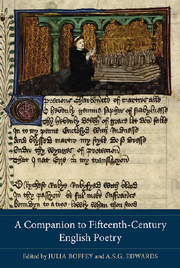Book contents
- Frontmatter
- Contents
- List of Contributors
- List of Abbreviations
- Conventions
- Introduction
- Part I Background and Context
- Part II Authors
- 3 Thomas Hoccleve
- 4 Thomas Hoccleve's Regiment of Princes
- 5 John Lydgate's Major Poems
- 6 John Lydgate's Religious Poetry
- 7 John Lydgate's Shorter Secular Poems
- 8 John Capgrave and Osbern Bokenham: Verse Saints' Lives
- 9 Peter Idley and George Ashby
- 10 John Audelay and James Ryman
- Part III Themes and Genres
- Chronology
- Index of Manuscripts
- General Index
6 - John Lydgate's Religious Poetry
from Part II - Authors
Published online by Cambridge University Press: 05 July 2013
- Frontmatter
- Contents
- List of Contributors
- List of Abbreviations
- Conventions
- Introduction
- Part I Background and Context
- Part II Authors
- 3 Thomas Hoccleve
- 4 Thomas Hoccleve's Regiment of Princes
- 5 John Lydgate's Major Poems
- 6 John Lydgate's Religious Poetry
- 7 John Lydgate's Shorter Secular Poems
- 8 John Capgrave and Osbern Bokenham: Verse Saints' Lives
- 9 Peter Idley and George Ashby
- 10 John Audelay and James Ryman
- Part III Themes and Genres
- Chronology
- Index of Manuscripts
- General Index
Summary
In the fervent, contentious, and sometimes ostentatious religious culture of fifteenth-century England, one writer stands out as a particularly prolific and versatile author of devotional texts: the monk of Bury St Edmunds, John Lydgate (c.1370–1449). Lydgate wrote thousands of lines of religious poetry for a wide range of patrons, both individual and institutional, and his poetry provides a comprehensive picture of orthodox fifteenth-century English religious life and its concerns: highly sacramental, habitually influenced by meditative spirituality and imitatio Christi, defiantly anti-Lollard, and profoundly invested in the cults of the saints and of the Virgin. Perhaps more surprisingly, however, Lydgate's religious poetry is, like his more overtly political poems, often highly topical. Lydgate was long viewed as a repetitive monk, cloistered in self-indulgent rhetoric (Mortimer 2005: 2–20, summarises the relevant unflattering assessments and Lydgate's changing critical fortunes). Now, Lydgate is increasingly seen as a poet who innovated and experimented: he negotiated the vernacular translation of religious material, the incorporation of Chaucerian diction and themes, and the use of aureate language and humanist ideas all within the parameters of orthodoxy. Lydgate's poetry also inaugurates several new European traditions into English devotional culture: subjects such as the Dance of Death and visual-material forms such as mural poetry and the pietà or image of pity find early English expressions in Lydgate's poetry. In short, Lydgate provides us with a ready conspectus of religious literary forms, from short prayers to epic narratives, poised between cloistered monasticism and a vigorous patronage culture of ‘pray and display’.
- Type
- Chapter
- Information
- A Companion to Fifteenth-Century English Poetry , pp. 73 - 86Publisher: Boydell & BrewerPrint publication year: 2013



